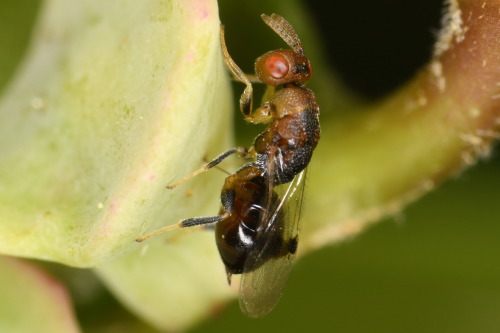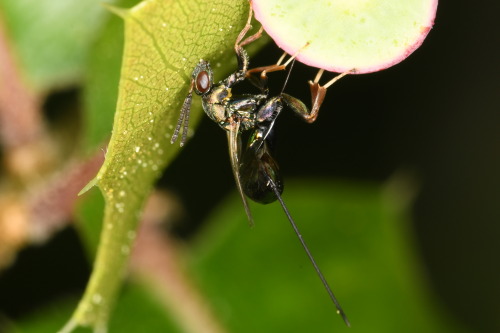So Many Gall Parasitoids! They Were All Going To Town On Those Amphibolips Galls, Occasionally Pushing










So many gall parasitoids! they were all going to town on those Amphibolips galls, occasionally pushing eachother off them in order to oviposit
Genus Torymus, Genus Sycophila Genus Eurytoma, Genus Torymus Genus Sycophila, Genus Sycophila Genus Eurytoma, Genus Sycophila Family Torymidae, Genus Eurytoma
More Posts from Northerlyy and Others


Non-Biting Midge (Xylotopus par), male, taken February 26, 2025, in Georgia, US
Despite how he looks, this guy is very much alive and flew off shortly after I took these pictures! I swiped him out of the sky and shook him around in my hand to stun him so I could get pictures, hence his totally shocked appearance.
This guy is one of the cousins of the arguably less friendly mosquito! I really enjoy photographing midges, but as I'm not super knowledgeable of them yet, I mostly rely on IDers (THE IDer in the case of this family) on iNat to point me in the right direction. One of the first things I learned is that males of this family can easily be differentiated from females by their long, thin abdomens and big, fuzzy antennae! This is also the case for mosquitos and most other nematoceran flies, though it can be very hard to tell when it comes to groups like crane flies, who can be more reliably sexed by their abdomen!

Spiny Assassin Bug (Sinea spinipes), taken May 5, 2025, in Georgia, US
Spiny, indeed! Look at those legs! The nymphs of this species are mostly black with a yellow abdomen, quite different from the brown camouflage of adults. If you're not looking closely, adults can be overlooked at a brown spot on leaves or part of tree bark. They're quite good at what they do! I usually only find nymphs, so finding this adult hiding in the leaves was a nice treat!

Red-shouldered Bug (Jadera haematoloma), taken April 4, 2025, in Georgia, US
Just a little guy posing for a picture! He seemed to be following the camera as I tried to get different angles. This insect has two adult morphs: long-winged (macropterous) and short-winged (brachypterous). The short-winged morph has, as you could infer, shorter wings that leave part of the abdomen exposed. I've seen both forms in a solitary setting, though this species apparently tends to have higher rates of short-winged adults when they live in groups. Less need for wings when you don't have to go anywhere to find a mate!

I've got you. A very small (chalcidoid) wasp checking out a bunch of aphids...
Busy today, so no nice bugs. However, perhaps you could take a moment to imagine…a very small wasp. Wow. Nice.


White-throated Sparrows (Zonotrichia albicollis), taken February 10, 2025, in Georgia, US
A couple cuties posing at the bird bath! Sparrows just keep growing on me—I love it when they look over their shoulders at me 🥺


Red-headed Ash Borer (Neoclytus acuminatus), taken May 21, 2025, in Georgia, US
Another lifer beetle for me! It shouldn't be surprising, but it feels like everywhere I go I'm finding new longhorn beetles—round-necked ones especially! A lot are just the same colors recycled in different patterns, and I find it a bit funny. This guy was quite pretty and allowed me to take several photos before getting too shifty. I would also be bothered if a giant appeared and started manhandling the leaf I was sitting on, but this individual was brave and waited patiently for me to leave. How generous!
How cute!! I'm glad the males and females have finally reunited for spring! Down here they didn't spend the night, but we have a bunch of feeders so flocks of males were coming through constantly. It wasn't unusual to see 30 or 40 on the ground at once, milling around in a sea of black. It was incredibly loud! We also had the migrating robins visiting in the hundreds, and along with all the year-rounders it was a very very busy winter.

Red-winged Blackbird (Agelaius phoeniceus), juvenile male, taken February 26, 2025, in Georgia, US
The last of the blackbirds are finally making their way out! Instead of hundreds in a day, we are now only seeing 1 or 2 stragglers stop for a snack. Kind of sad to see them go because they're beautiful, but I can also hear the song of other birds now that they're not screaming over them lol, so that's nice! The woods are quiet without them, but that's not such a bad thing.


Crab Spiders (Genus Mecaphesa), taken April 12, 2025, in Georgia, US
Some crab spiders hiding underneath flowers! This is a known undescribed species, currently labeled "black tibia spot" (for obvious reasons) as far as I know. I see them pretty often hanging out, especially on fleabane flowers like this. Crab spiders are ambush predators, and most in the genus Mecaphesa lie in wait on similarly-colored flowers until a prey item (flies, beetles, and perhaps small bees) lands on it. The spider quickly overtakes its prey and hides underneath the petals of the flower to enjoy. A rather boring life for us, but these guys don't seem to mind!

Vetch Looper Moth (Caenurgia chloropha), taken April 2, 2025, in Georgia, US
It's new moth season! I'm seeing lots of inchworms dropping from the trees as well as lots of seasonal moths! It's nice to see something more than renia moths for once lol. This guy was a little skittish, but ultimately let me get some pictures. Most moths are much worse subjects!

Ichneumon Wasp (Limonethe maurator), taken August 17, 2024, in Georgia, US
A lithe wasp for the wasp-likers! I can't wait for it to be wasp season again... The paper wasps are back out, and I swear I saw a spider or great black digger wasp in the leaves the other day, but it flew away before I could get a good look. I also found and lost a damselfly I've never seen before, but I can stop being salty about that when I find another one (hopefully). Regardless, the wasps are coming back, and here is one I look forward to seeing again!
-
 a1-1976 liked this · 1 week ago
a1-1976 liked this · 1 week ago -
 fogandfireflies liked this · 3 weeks ago
fogandfireflies liked this · 3 weeks ago -
 thousandyearphantombunker reblogged this · 4 weeks ago
thousandyearphantombunker reblogged this · 4 weeks ago -
 thousandyearphantombunker liked this · 4 weeks ago
thousandyearphantombunker liked this · 4 weeks ago -
 robbiedebruler liked this · 1 month ago
robbiedebruler liked this · 1 month ago -
 abbenai reblogged this · 1 month ago
abbenai reblogged this · 1 month ago -
 ants-in-technicolour reblogged this · 1 month ago
ants-in-technicolour reblogged this · 1 month ago -
 microglialcell liked this · 1 month ago
microglialcell liked this · 1 month ago -
 fr00gyx3 liked this · 1 month ago
fr00gyx3 liked this · 1 month ago -
 locomalparido liked this · 1 month ago
locomalparido liked this · 1 month ago -
 randomcollection-o-stuff liked this · 1 month ago
randomcollection-o-stuff liked this · 1 month ago -
 theymightbebipeds liked this · 1 month ago
theymightbebipeds liked this · 1 month ago -
 exactly24bees liked this · 1 month ago
exactly24bees liked this · 1 month ago -
 northerlyy reblogged this · 1 month ago
northerlyy reblogged this · 1 month ago -
 northerlyy liked this · 1 month ago
northerlyy liked this · 1 month ago -
 hawkpartys reblogged this · 1 month ago
hawkpartys reblogged this · 1 month ago -
 khaoticemerald liked this · 1 month ago
khaoticemerald liked this · 1 month ago -
 piceacamellia liked this · 1 month ago
piceacamellia liked this · 1 month ago -
 eternalmitosis liked this · 1 month ago
eternalmitosis liked this · 1 month ago -
 beanbeetle liked this · 1 month ago
beanbeetle liked this · 1 month ago -
 ogboggle liked this · 1 month ago
ogboggle liked this · 1 month ago -
 mr-pages-things liked this · 1 month ago
mr-pages-things liked this · 1 month ago -
 coldcanadianwinters liked this · 1 month ago
coldcanadianwinters liked this · 1 month ago -
 ichneumonidz liked this · 1 month ago
ichneumonidz liked this · 1 month ago -
 ryugel liked this · 1 month ago
ryugel liked this · 1 month ago -
 littlemxunearthly liked this · 1 month ago
littlemxunearthly liked this · 1 month ago -
 mantischildren reblogged this · 1 month ago
mantischildren reblogged this · 1 month ago -
 thesewersofparis liked this · 1 month ago
thesewersofparis liked this · 1 month ago -
 rekekiss25 liked this · 1 month ago
rekekiss25 liked this · 1 month ago -
 millipedesonthebrain liked this · 1 month ago
millipedesonthebrain liked this · 1 month ago -
 esoteric-brustle reblogged this · 1 month ago
esoteric-brustle reblogged this · 1 month ago -
 ramskeleton reblogged this · 1 month ago
ramskeleton reblogged this · 1 month ago -
 junoniadoesart liked this · 1 month ago
junoniadoesart liked this · 1 month ago -
 hawkpartys reblogged this · 1 month ago
hawkpartys reblogged this · 1 month ago -
 duckghosttoad liked this · 1 month ago
duckghosttoad liked this · 1 month ago -
 hymenoptera07 liked this · 1 month ago
hymenoptera07 liked this · 1 month ago -
 tinyyellowflowers-blog liked this · 1 month ago
tinyyellowflowers-blog liked this · 1 month ago -
 siberiantrap liked this · 1 month ago
siberiantrap liked this · 1 month ago -
 theoyoyoyo liked this · 1 month ago
theoyoyoyo liked this · 1 month ago -
 fishteeth0 liked this · 1 month ago
fishteeth0 liked this · 1 month ago -
 jakarraelcorby reblogged this · 1 month ago
jakarraelcorby reblogged this · 1 month ago -
 honeycomb-butch reblogged this · 1 month ago
honeycomb-butch reblogged this · 1 month ago -
 proton-wobbler reblogged this · 1 month ago
proton-wobbler reblogged this · 1 month ago -
 nohriantomatoes liked this · 1 month ago
nohriantomatoes liked this · 1 month ago -
 asgardian--angels liked this · 1 month ago
asgardian--angels liked this · 1 month ago -
 forestfeeling reblogged this · 1 month ago
forestfeeling reblogged this · 1 month ago -
 forestfeeling liked this · 1 month ago
forestfeeling liked this · 1 month ago -
 happy-amoeba liked this · 1 month ago
happy-amoeba liked this · 1 month ago -
 hawkpartys reblogged this · 1 month ago
hawkpartys reblogged this · 1 month ago -
 sagesilentfire liked this · 1 month ago
sagesilentfire liked this · 1 month ago

Wildlife photography of all kinds in no particular chronological order... call me North!All photos posted are taken by me, and everything that appears here is documented on iNaturalist as well.
242 posts